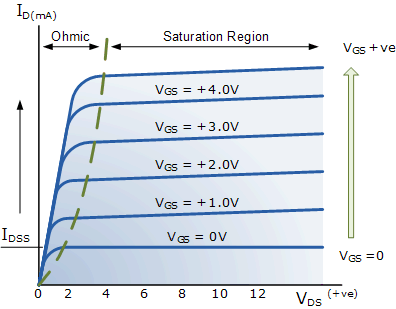To turn on a N-Channel Enhancement-type MOSFET, apply a sufficient positive voltage VDD to the drain of the transistor and a sufficient positive voltage to the gate of the transistor. This will allow a current to flow through the drain-source channel. So with a sufficient positive voltage, VDD, and sufficient positive voltage applied to the gate, the N-Channel Enhancement-type MOSFET is fully functional and is in the. The channel nearer to drain gets more depleted than at source (like in FET) and the current flow decreases due to this effect. Hence it is called as depletion mode MOSFET. Working of N-Channel MOSFET (Enhancement Mode) The same MOSFET can be worked in enhancement mode, if we can change the polarities of the voltage V GG. The applet above calculates and plots the output characteristics of an n-channel (enhancement-mode) MOSFET. Try to change the drain-source voltage (Vds) range and/or the gate bias starting value ('begin') or other values and see the drain current vs. Drain bias (Vds) change.

The N-Channel MOSFET has an N- channel region located in between the source and drain terminals. It is a four-terminal device having the terminals as gate, drain, source, body. In this type of Field Effect Transistor, the drain and source are heavily doped n+ region and the substrate or body are of P-type. In N-channel D-MOSFET, the source, drain and channel are made during the manufacturing from N-type material upon a P-substrate. The channel contains electrons as charge carriers. There is a metal oxide insulating layer between the gate electrode and the channel or P-substrate.
Difference between enhancement and depletion type mosfet
N Channel Enhancement Mosfet Pdf
Depletion mode MOSFET is normally turned on at zero gate voltage. Such devices are used as load resistors.
MOSFETs with enhancement modes are the common switching elements in most MOSs. These devices are deactivated at zero gate voltage and can be switched on by powering the gate.
In field effect transistors (FET), exhaust mode and amplification mode are two major types of transistor, corresponding to whether the transistor is in the ON or OFF state at zero gate-source voltage.
Enhancement MOSFET

MOSFETs with enhancement modes can be switched on by powering the gate either higher than the source voltage for NMOS or lower than the source voltage for the PMOS.

In most circuits, this means that pulling a MOSFET gate voltage into the leakage boost mode becomes ON.

For N-type discharging devices, the threshold voltage could be about -3 V, so it could be stopped by dragging the 3 V negative gate (leakage by comparison is more positive than the NMOS source).
In PMOS, polarities are reversed.
The mode can be determined by the voltage threshold sign (gate voltage versus source voltage at the point where only a layer inversion is formed in the channel):
- For a N-type FET, modulation devices have positive and depleted thresholds – modulated devices have negative thresholds;
- For a P-type FET, positive mode to improve negative mode, depletion.
Depletion MOSFET
Junction-effect junction transistors (JFET) are the depletion mode because the gate junction would transmit the bias if the gate was taken more than a bit from the source to the drain voltage.
Such devices are used in gallium-arsenide and germanium chips, where it is difficult to make an oxide isolator.
Figure describes the construction of MOSFET type of exhaustion. Also note the MOSFET circuit type N exhaust channel symbol.
N Channel Enhancement Mosfet Construction
Due to its construction, it offers very high entry strength (approximately 1010 to 1015). Significant current flows for VDS data at 0 volts VGS.
When the gate (ie, a capacitor plate) is made positive, the channel (i.e., the other capacitor plate) will have a positive charge induced therein.
Enhancement Mode N Channel Mosfet
This will lead to the depletion of the major bearers (ie electrons) and therefore to the reduction in conductivity.
Difference between enhancement and depletion type mosfet in tabular form
Mosfet Enhancement Mode

| Sr.No. | Depletion MOSFET (D-MOSFET) | Enhancement MOSFET (E-MOSFET) |
| 1 | It is called a depletion MOSFET because of channel depletion. | It only works in enhancement mode and is therefore called Enhancement MOSFET. |
| 2 | It can be used as E-MOSFET. | It can not be used as a D-MOSFET. |
| 3 | If Vgs = 0 V, Ids flows due to Vds. | If Vgs = 0V, Ids = 0, although Vds is applied. |
| 4 | N-type semiconductors exist in the structure itself between source and drain. | There is no n-channel between source and drain. |
| 5 | Do not occur | When Vgs = Vt, the MOSFET is turned on. |
Now you know difference between enhancement and depletion mosfet.
